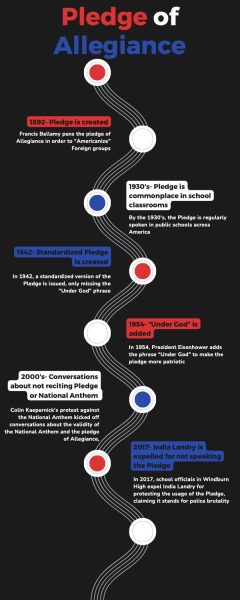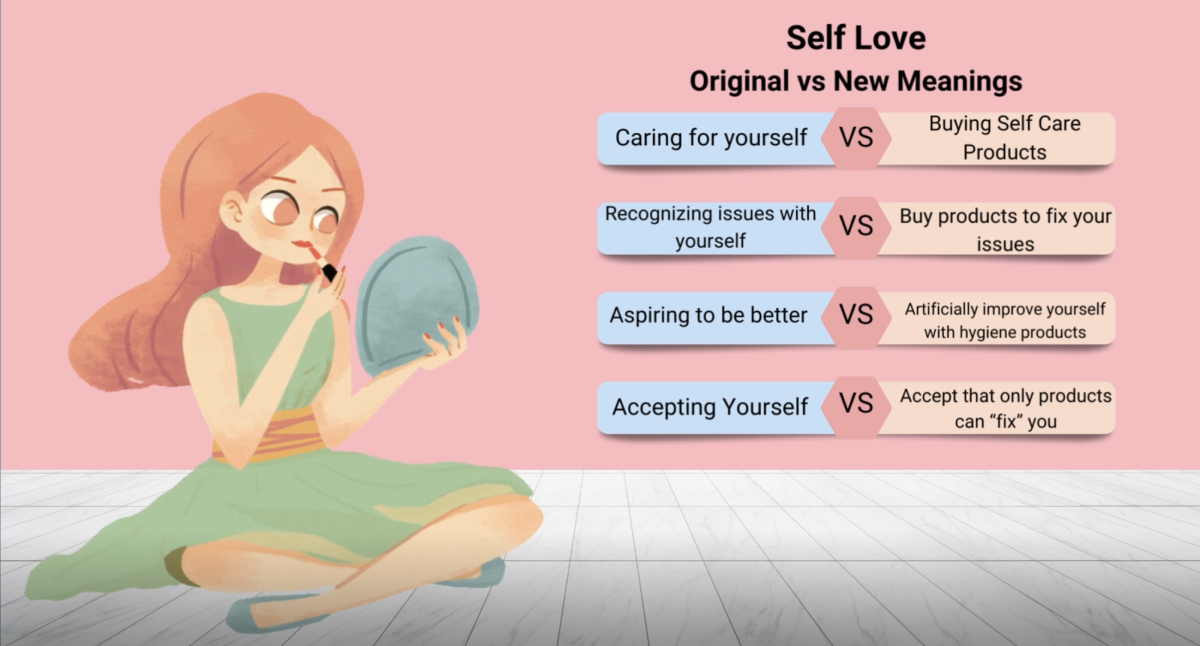In origin, The American Pledge of Allegiance was created to fill the purpose of marketing The United States of America and how great of a place to live it was. In 1892, on the four hundredth anniversary of Columbus arriving in America, Baptist Minister Francis Bellamy drummed up the idea and execution of the Pledge of Allegiance to accomplish this illustrious goal, according to history.com.
Bellamy penned the Pledge to “Americanize” public schools across the nation. Over the years, the Pledge changed and evolved into the version we see and hear in public schools throughout the country. The “under god” line was added in 1954, to combat the Soviet Union, which was referred to by America as “godless”, as the Soviet Union had no official religion.
Today, American public schools across the nation continue to espouse the Pledge as a daily part of their agendas. As much as 40 percent of all Americans recited the Pledge at least through elementary school, making it a staple verse in American history, according to statcrunch.com.
While the Pledge is considered a patriotic item of a timeless nature, there are many critics who criticize it for its dubious history and what its underlying nature means. Bellamy created the Pledge with the sole purpose of helping foreign groups conform to American ideals. Groups like catholic immigrants were targets for this conformity crusade, as these new Americans were forced to rapidly learn the American way or be ostracized, according to history.com.
The conformity aspect of the Pledge extends to other groups of marginalized people. Jewish, Irish and other non-white immigrants were introduced to the Pledge through the schooling system and popular culture, quickly subsuming it as a quintessentially American ideal.
The inclusion of “under god” also reinforced this notion of Protestant supremacy, as with its addition to the Pledge, it furthered the meaning of being American to not just being Patriotic, but also being religious, according to washington post.com.
Computer teacher at Omaha North High School, Natalie Runyon, remembers reciting the Pledge at her childhood school.
“I really, truly have no problem with it, [The Pledge] but I don’t think it should be said every day,” Runyon said.
This sentiment leans toward another view of the Pledge, that its relevance has begun to wane in recent years.

The simple idea of rebellion against the Pledge of Allegiance has existed since the Pledge itself came into being. In 1940, the case, Minersville School District v. Gobitis, came to the decision that public schools could force children to recite the pledge. This decision came after a Jehovah’s Witness was forced to speak the Pledge, which went against their religious doctrine, according to constitutioncenter.org.
This decision was reversed in the 1943 case, West Virginia State Board of Education v. Barnette, where the Globtis decision was struck down as the court ruled, “the Free Speech clause of the First Amendment prohibits public schools from forcing students to salute the American flag and say the Pledge of Allegiance,” according to contitutioncenter.org.
The root of the issue concerning the Pledge and its relevance in Public Schools comes from the problematic nature of forcing children to recite biased information that favors a particular view of the United States. In common language, this is the definition of propaganda. Alexander James, 11, a student at Omaha North High School, sees the propaganda of the Pledge but views it as positive patriotism.
“America does a good job of using Propaganda subtly,” James said. “I do think the Pledge could be viewed as Propaganda, but I think that it is obvious enough, blatant enough, that it is not a tremendous issue.”
Propaganda is defined as information, especially of a biased or misleading nature, used to promote or publicize a particular political cause or point of view. This definition fits the Pledge like a glove fits a hand, which consequently makes its inclusion in school classrooms even more damning.
The allegiance to the Pledge stands true for many Americans, however. The nostalgic or patriotic spirit, the feel for order and sustainability, galvanizes the Pledge in many American minds, both young and old. James believes that the Pledge brings tremendous value to the American way of life.
“We said the Pledge every day, it wasn’t even really thought about, it was part of the daily routine,” James said. “I think overall… the people made the pledge to make people feel patriotic, they wanted people to like where they come from, to have a sense of respect and love.”
James love for America and respect for the Pledge stems from his longstanding ideals and beliefs regarding patriotism. James is a higher up in the Junior Reserve Officers Training Corps (JROTC). This position gives him the patriotic spirit to continue to recite the Pledge to this day, while many of his peers do not.
Each line in the Pledge is dripping with external rhetoric, “I pledge allegiance, to the flag” begins the pledge with a pledge to a symbol, namely the American Flag. This pledge comes with the implication that you will serve the American nation and considering the checkered past of our nation, many would disagree and renounce the flag and all its hypocritical symbolism.
The line, “one nation, under god” houses arguably the most insidious aspect of the pledge. The idea that you are pledging your allegiance to the expressly Judeo-Christian God, in a country that is supposed to practice freedom of religion, is very hypocritical. Considering the Pledge is a form of propaganda, this propaganda extends to religion, which directly contradicts the freedom of religion clause.
Bellamy’s role in the creation of the Pledge, combined with his worldview, caused the Pledge to become a beacon of the traits and values of a true American. He believed that true American values were enshrined as predominantly white, protestant, and committed to the American way of life. This heavy bias contributed to a feeling of exclusion from racial, ethnic and religious minorities.
Antonisha Harrold, 12, a student at Omaha North High School, has strong opinions on the Pledge, because of these biases.
“I feel like the Pledge is for white people and people of military history.” When asked to clarify, Harrold said, “Because it’s not really giving people in poverty too much, [in regard to credit, recognition, etc.]”
Harrold’s feelings of disillusionment towards the pledge circle back to the original purpose of it. The pledge was made to bring a sense of unity to Bellamy’s sense of a patriotic American. Those Americans that don’t fit into Bellamy’s view, such as people of color and other minorities are excluded from the message the pledge sends.
Finally, the line, “with liberty and justice for all” serves as propaganda, as it addresses an ideal that America itself does not follow in practice. Throughout America’s history, it has subjugated those not deemed “American enough.”
The Native American genocide is a prime example of this double standard. Because White Americans needed land to expand into, the American Natives who lived in said land were kicked out and exterminated, today only about 7 million Natives live in the United States, compared to 75 million in 1492, according to se.edu.
Due to these critiques and compliments, the Pledge deserves to ultimately become a relic of the past, delegated to solely patriotic duties and rituals. Its inclusion into daily student life is an annoying burden that only serves to differentiate Bellamy’s version of America from that of an inclusive and diverse America.
The Pledge of Allegiance continues to impact and influence American culture to this very day, continuing a long tradition of good old fashioned American propaganda. While its inclusion into everyday life is slowly falling away, its influence should forever be squandered, in the hopes that this country we live in can truly become filled with liberty and justice for all.



